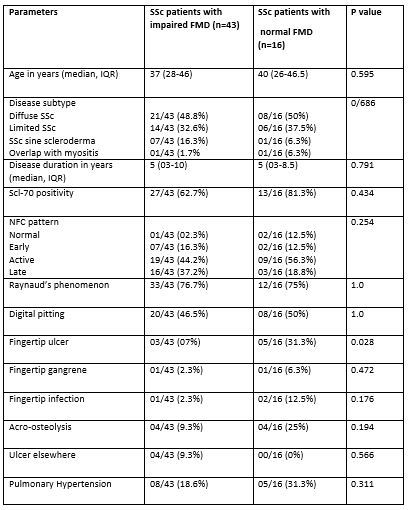Session Information
Date: Monday, November 8, 2021
Title: Systemic Sclerosis & Related Disorders – Clinical Poster II (1364–1390)
Session Type: Poster Session C
Session Time: 8:30AM-10:30AM
Background/Purpose: Microvascular dysfunction is a key and determining feature of scleroderma (SSc). But contrary to earlier belief there is emerging evidence to suggest co-occurrence of macrovascular dysfunction. The clinical implication of macrovascular dysfunction in SSc is unknown and its correlation with microvascular dysfunction is inconclusive. Therefore the objectives of this study were to assess the prevalence and clinical impact of macrovascular dysfunction in a cohort of SSc. To study the correlation between macrovascular dysfunction as assessed by percent change in flow mediated vasodilation (FMD) of brachial artery and microvascular dysfunction as assessed by nail fold capillaroscopy (NFC) findings in SSc.
Methods: Cross-sectional comparative study enrolled SSc patients (n=59) and age & gender matched healthy controls (n=64). FMD change was calculated using standard USG probe (6 MHz) in right brachial diameter from the average of 3 consecutive end diastolic frames. NFC was performed using portable nail fold capillary microscope at 800X magnification. Clinical features of SSc were compared between SSc patients with and without macrovascular dysfunction.
Results: SSc had significantly (p < 0.001) lower FMD change (median-4.54, IQR 3.13-8.82) compared to healthy controls (median – 10.30, IQR 8.33-13.16). Two out of every three SSc patients 43/59 (66.2%) had impaired FMD. We replicated significantly (p-value< 0.0001) lower capillary density (median – 3.19, IQR 2.38-3.94) in SSc compared to healthy controls (median – 7.56, IQR 7.06-8.0) (Table 01). Impairment in FMD was not associated with Raynaud’s phenomenon, digital gangrene, digital ulcer, acro-osteolysis or pulmonary hypertension suggesting need for a prospective study to identify the implications (Table 02). Magnitude of NFC findings and FMD changes did not corelate with the impairment in FMD among SSc patients (Fig. 01)
Conclusion: About 2/3rd of patients with SSc have macrovascular complications but their clinical implications may need long term prospective follow up. Macrovascular and microvascular dysfunction appears to be independent of each other in SSc.
 Table 1: Comparison of parameters between the SSc patients with healthy controls (*P value < 0.001)
Table 1: Comparison of parameters between the SSc patients with healthy controls (*P value < 0.001)
 Table 2: comparison of macrovascular complication between SSc patients with or without impaired FMD
Table 2: comparison of macrovascular complication between SSc patients with or without impaired FMD
 Fig.1: Correlation of FMD percent change with (a) average capillary density (b) abnormal capillaries and (c) % avascular area
Fig.1: Correlation of FMD percent change with (a) average capillary density (b) abnormal capillaries and (c) % avascular area
To cite this abstract in AMA style:
Bairwa D, Kavadichanda C, Shah s, Mathew A, dunga s, Gopal A, Thabah M, Negi V. Macrovascular Dysfunction and Its Clinical Implication in Systemic Sclerosis [abstract]. Arthritis Rheumatol. 2021; 73 (suppl 9). https://acrabstracts.org/abstract/macrovascular-dysfunction-and-its-clinical-implication-in-systemic-sclerosis/. Accessed .« Back to ACR Convergence 2021
ACR Meeting Abstracts - https://acrabstracts.org/abstract/macrovascular-dysfunction-and-its-clinical-implication-in-systemic-sclerosis/
